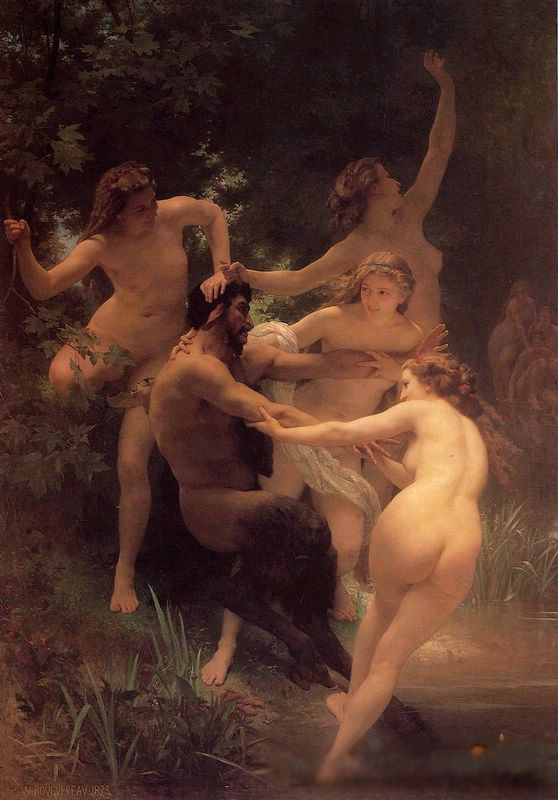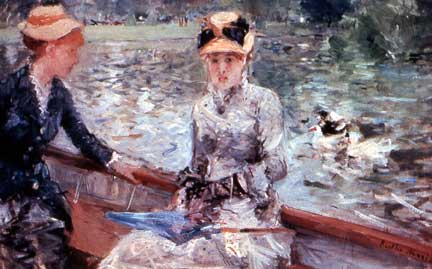Le Salon
The Prevailing Art World
In the late 19th century, there was only ONE way for artists to become successful and that was to have their paintings seen at Le Salon.
The Salon was France’s annual, official art show. Artists who won prizes at the Salon also received lucrative commissions to create work of art for the government. It was important to exhibit at the Salon because it was of the only ways to get recognition for one’s work and to find new patrons.
The Salon approved conservative paintings that illustrated and taught moral lessons using historical, religious or mythological subjects.
William Bouguereau

Color
Academic artists often used deep, rich colors and dark shadows
Nature
Nature was primarily as a backdrop for a story. it was changed or embellished to best suit the purpose of drama unfolding before it, perhaps a grand and tempestuous sky split open by heavenly sunrays, or a delicate and softly lit garden containing classical runs.
(French, 1825 - 1905
Nymphs & Satyr, 1873
Composition
Traditional compositions were theatrical and monumental, focused on a central action or group of figures. Figures were larger - than - life and possessed spectacular, identical bodies.
Brushwork
Traditional works were meticulously painted with smooth, carefully finished surfaces intended to hide all traces of the artist's brushwork. They were designed to create the illusion that viewers could look right through the frame of a painting and into a real scene beyond.
When the Impressionists submitted paintings to the Salon, their work were usually rejected! The Salon jury encouraged and rewarded traditional paintings. To them, the work of Impressionists, with its loose brushwork and daring colors, seemed shocking, unfinished and insulting.
Berthe Morisot

Nature
The Impressionists considered nature to be a worthy subject in its own rights. Unlike academic artists, they painted real life landscapes as they saw them and without idealization.
Color
The Impressionists used vibrant, light colors, sometimes mixed directly on the canvas, in strong contrast with the darker palettes of traditional art.
Themes
Rather than painting historical religious or mythological subjects, the Impressionists chose to paint everyday scenes from the world they knew.
Brushwork
Fascinated with capturing the fleeting moment, Impressionists applied their paint with quick, spontaneous brushstrokes. There were not concerned with a meticulous finish.
Composition
Unhampered by traditional rules, the Impressionists experimented with composition, often framing or cropping their subjects in ways that were shocking to the prevailing art world.
(French, 1841 - 1895)
Summer's Day, ca. 1879
Oils on canvas
“[Berthe Morisot] grinds flowers petals onto her palette so as to spread them later on her canvas with airy, witty touches….” – Charles EpbrussiThe Impressionists were frustrated with the narrow range of work encouraged by the official Salon. To them, traditional painting seemed outdated and irrelevant.
Career of a Salon Artist
At the age of fifteen Jean Leon Gerome (1824 – 1904) left his home town of Vesoul for Paris to study with history painter Paul Delaroche. He established himself early on through a serious of painting depicting scenes from Greek antiquity. He received several important commissions and achieved success at the state sponsored Salon. Some of his more popular painting were from scenes influenced by his travel to Egypt and the East. He was a well – liked professor at the Ecole de Beaux – Arts, he instructed several Impressionists artists including Renoir.
However, he ardently rejected Impressionism and did everything he could to exclude them from exhibiting at the Salon.
The world of Impressionism and how it came to be. It was not an easy road for Impressionists to get to the title to which they claim today. They had to suffer through a few hardships and criticism. To read more about this and continue please click here.
